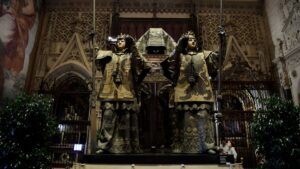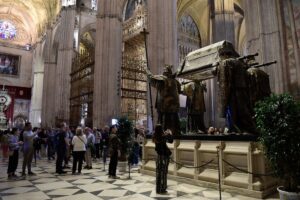
After Columbus’ body was moved several times after his death, a hunt was started to locate the navigator’s remains with some scholars claiming he was laid to rest in the Dominican Republic before the latest ground-breaking discovery
The 500-year-old mystery surrounding Christopher Columbus’ last resting site has been resolved by scientists thanks to DNA analysis.After 20 years of DNA analysis, the team was able to “absolutely confirm” that the human bones discovered buried in the Cathedral of Seville, Spain, belonged to the adventurer who died in 1506. They have been comparing the samples’ DNA with those of kin and descendants for the last 20 years. A search was launched to find the navigator’s remains after Columbus’ body was transferred multiple times after his death. According to some experts, he was buried in the Dominican Republic.
“Today it has been possible to verify it with new technologies, so that the previous partial theory that the remains of Seville belong to Christopher Columbus has been definitively confirmed,” Miguel Lorente, a forensic scientist who led the investigation, said on Thursday.

According to some experts, Columbus was buried in the Dominican Republic.
Although many experts have long assumed that Columbus’ remains has been in the tomb inside the cathedral, it wasn’t until 2003 that Lorente and historian Marcial Castro were given permission to open it and discover the previously unidentified bones within. DNA technology at the time was unable to accurately provide results by “reading” a small bit of genetic material.
The remains of the explorer’s brother Diego and son Hernando, who are also interred at Seville Cathedral, were used by researchers. Additionally, the relative’s bones were far larger than the pieces discovered in Columbus’s grave. The scientific world has also argued about whether the explorer was Italian, and advances in DNA research may help determine this.
According to some experts, Columbus was buried in the Dominican Republic.
While some have proposed Poland or Spain as his birthplace, others are certain he was born in Genoa. The navigator may have been Scottish, Catalan, or Jewish, according to several theories.
The “Columbus DNA: The genuine origin'” program, which will air on Spain’s national broadcaster TVE on Saturday, will reveal the researchers’ findings regarding Columbus’ lineage. While not disclosing the findings, Lorente told reporters that the research had validated earlier theories that the remains in Seville were those of Christopher Columbus.
Click here to follow the Mirror US on Google News to stay up to date with all the latest news, sports and entertainment stories
According to some experts, Columbus was buried in the Dominican Republic.
Numerous issues, especially the volume of data, have hindered nationality research. However, Lorente stated that “the outcome is almost absolutely reliable.”
In search of a path to the legendary riches of Asia, Columbus sailed from the Spanish port of Palos on August 3, 1492. Columbus and about 100 men set out on a journey that would take them to the opposite side of the planet, far from their initial target, along with three ships: the Nina, the Pinta, and the Santa Maria.The ships landed in the present Bahamas on October 12, 1492. Later that month, Columbus discovered Cuba and mistakenly believed it to be mainland China.